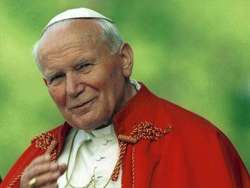St. John Paul II
St. John Paul II
Birth Name: Karol Józef Wojtyła
Born: May 18, 1920 in Wadowice, Republic of Poland
Died: April 2, 2005 (84 years old) in Apostolic Palace, Vatican City
Nationality: Polish, with Vatican citizenship
EARLY LIFE
St. John Paul II was born Karol Jozef Wojtyla on May 18, 1920 in Wadowice, Poland. His early life was marked with tragedy as his mother died when he was 9 years old and his brother Edmund died when he was 12 years old. As the Saint stated in his writings, his father did all that was possible to create what he would later refer to as his "first seminary" or the "domestic church" because the message of the Gospel was not for Sunday alone, but for everyday. Karol´s days were filled with assisting at the Mass as an altar server, studying, and sports, such as swimming and skiing.
NAZI INVASION
In 1938, Karol attended the world renowned Jagiellonian University were he studied theatre and poetry. Nazi troops invaded Poland on September 1, 1939. With that the schools and universities closed. Karol´s life was turned upside down as the attrocities of the Nazi invasion played over day by day. Adding to this devastation, his beloved father died. Karol was left all alone. With the madness of war all around him and grieving his father´s death, Karol searched for answers. It was during this time that he felt the call to the priesthood
Wanting to become a priest, John Paul began studying at a secret seminary run by the archbishop of Krakow. After World War II ended, he finished his religious studies at a Krakow seminary and was ordained in 1946.
Rise Within the Church
John Paul spent two years in Rome where he finished his doctorate in theology. He returned to his native Poland in 1948 and served in several parishes in and around Krakow. John Paul became the bishop of Ombi in 1958 and then the archbishop of Krakow six years later. Considered one of the Catholic Church´s leading thinkers, he participated in the Second Vatican Council—sometimes called Vatican II. The council began reviewing church doctrine in 1962, holding several sessions over the course of the next few years. As a member of the council, John Paul helped the church to examine its position in the world. Well regarded for his contributions to the church, John Paul was made a cardinal in 1967 by Pope Paul VI.
Becoming Pope
In 1978, John Paul made history by becoming the first non-Italian pope in more than four hundred years. As the leader of the Catholic Church, he traveled the world, visiting more than 100 countries to spread his message of faith and peace. But he was close to home when he faced the greatest threat to his life. In 1981, an assassin shot John Paul twice in St. Peter´s Square in Vatican City. Fortunately, he was able to recover from his injuries and later forgave his attacker.
Legacy
A vocal advocate for human rights, John Paul often spoke out about suffering in the world. He held strong positions on many topics, including his opposition to capital punishment. A charismatic figure, John Paul used his influence to bring about political change and is credited with the fall of communism in his native Poland. He was not without critics, however. Some have stated that he could be harsh with those who disagreed with him and that he would not compromise his hard-line stance on certain issues, such as contraception.
In his later years, John Paul´s health appeared to be failing. At public appearances, he moved slowly and seemed unsteady on his feet. He also visibly trembled at times. One of his doctors also disclosed that John Paul had Parkinson´s disease, a brain disorder often characterized by shaking, in 2001. But there was never any official announcement about his illness from the Vatican.
John Paul II died on April 2, 2005, at the age of 84, at his Vatican City residence. More than 3 million people waited in line to say good-bye to their beloved religious leader at St. Peter´s Basilica before his funeral on April 8.
On July 5, 2013, waving the usual five-year waiting period, the Vatican announced that the Roman Catholic Church would declare Pope John Paul II a saint, and that the canonization ceremony would likely take place within the next 16 months. The Vatican also stated that Pope John XXIII, who headed the Catholic Church from 1958 until his death in 1963 and convened the Vatican II council, would also be declared a saint.
On September 30, 2013, Pope Francis announced that the canonizations of Pope John Paul II and Pope John XXIII would occur on April 27, 2014. The announcement of Pope John Paul II´s canonization came after the Vatican revealed that two miracles were attributed to the late pope. After a dying French nun, Sister Marie Simon-Pierre Normand, prayed to Pope John Paul II for during her battle with Parkinson´s disease—the same illness that killed the pope—she was cured. The second miracle involved a 50-year-old woman, who claimed that she was cured of a brain aneurysm after a photograph of Pope John Paul II spoke to her.
The official sainthood ceremony, held on April 27, 2014, brought together four popes. Pope Francis led the event to elevate Pope John Paul II and Pope John XXIII to sainthood, which was also attended by Francis´s predecessor Emeritus Pope Benedict.


